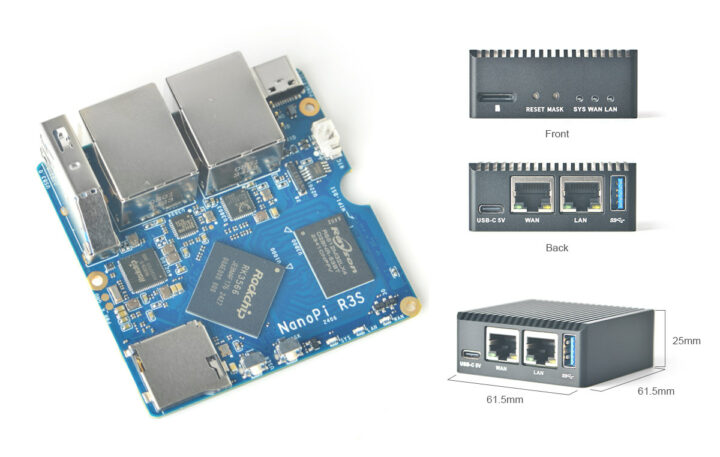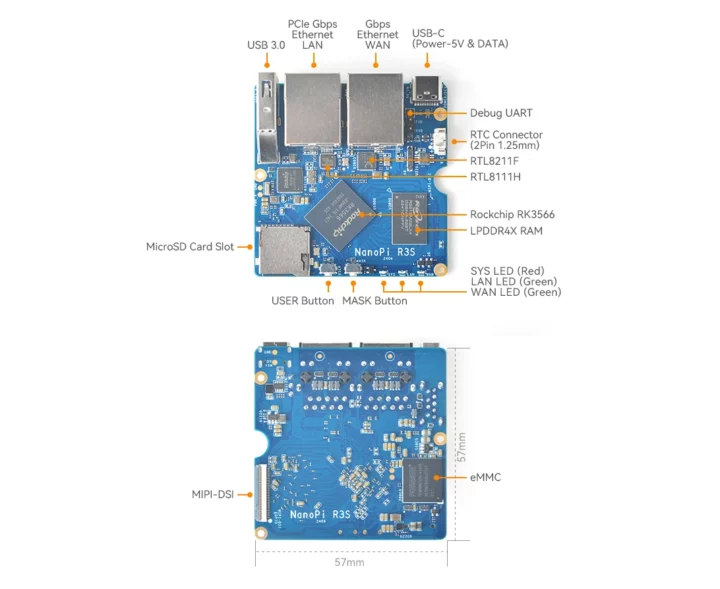FriendlyELEC NanoPi R3S is a low-cost Rockchip RK3566 SBC and router with two gigabit Ethernet ports, a USB 3.0 host ports, a USB-C port for power and data, a microSD card slot, Reset and Mask buttons, and a few LEDs. It also features a MIPI DSI connector for people wanting to connect a display.
Its design and size are similar to the NanoPi R5C dual 2.5GbE SBC and router, so it could be viewed as a low-cost alternative with dual GbE, no M.2 socket for WiFi & Bluetooth, only one USB 3.0 port, and no HDMI video output. The company promotes it as an inexpensive platform for IoT applications, basic NAS solutions, and so on.
NanoPi R3S specifications:
- SoC – Rockchip RK3566
- CPU – Quad-core Cortex-A55 processor @ up to 2.0 GHz
- GPU – Arm Mali-G52 MP2 GPU
- NPU – 0.8 TOPS AI accelerator
- VPU
- 4Kp60 H.265/H.264/VP9 video decoder
- 1080p60 H.264/H.265 video encoder
- System Memory – 2GB LPDDR4X
- Storage
- Optional 32GB eMMC flash
- MicroSD card socket
- Display Interface – 30-pin MIPI DSI FPC connector (CNXSoft: I could not find documentation about it nor a display known to work)
- Networking – 2x gigabit Ethernet RJ45 ports
- WAN via Realtek RTL8111H PCIe to GbE controller tested up to 934 Mbps (Tx) and 936 Mbps (Rx)
- LAN via Realtek RTL8211E tested up to 934 Mbps (Tx) and 941 Mbps (Rx)
- USB
- 1x USB 3.2 Gen 1 Type-A port
- 1x USB-C port for power and data (e.g. to flash firmware)
- Debugging – 3-pin UART header (1.5 Mbps baudrate)
- Misc
- Mask key for eMMC flash update
- User button
- 2-pin connector for RTC
- 3x user LEDs for SYS, LAN, WAN
- Power Supply – 5V via USB Type-C port
- Dimensions – PCB: 57 x 57 mm; enclosure: 61.5 x 61.5 x 25 mm
- Weight – 30 grams without the case, 144 grams with the metal enclosure
- Temperature Range – 0 to 80°C
FriendlyELEC provides Ubuntu Noble 24.04 Core, Debian 12 Core, OpenMediaVault 6.1, and FriendlyWrt (fork of OpenWrt 21.02 or 23.05) images for the board, all based on Linux 6.1.x and u-boot
v2017.09. They can be flashed to the eMMC flash via a microSD card or a USB-C cable through the eFlasher utility or booted directly from the microSD card. You’ll find documentation and OS images on the wiki.
I compared the NanoPi R5C in the introduced since both are based on Rockchip RK3566/RK3568 processor, but it’s more like an update to the Rockchip RK3328-based NanoPi R2S dual GbE IoT board and gateway with better performance and extra features like a USB 3.0 Type-A port and MIPI DSI. FriendlyELEC shows the R3S runs much cooler than the R2S when used in the same/similar metal enclosure.

The NanoPi R3S board can be purchased for as low as $30 without eMMC flash (or $35 with 32GB flash), and the metal case adds $5, so a complete kit with 32GB eMMC flash and a metal case sells for $40 plus shipping.

Jean-Luc started CNX Software in 2010 as a part-time endeavor, before quitting his job as a software engineering manager, and starting to write daily news, and reviews full time later in 2011.
Support CNX Software! Donate via cryptocurrencies, become a Patron on Patreon, or purchase goods on Amazon or Aliexpress






